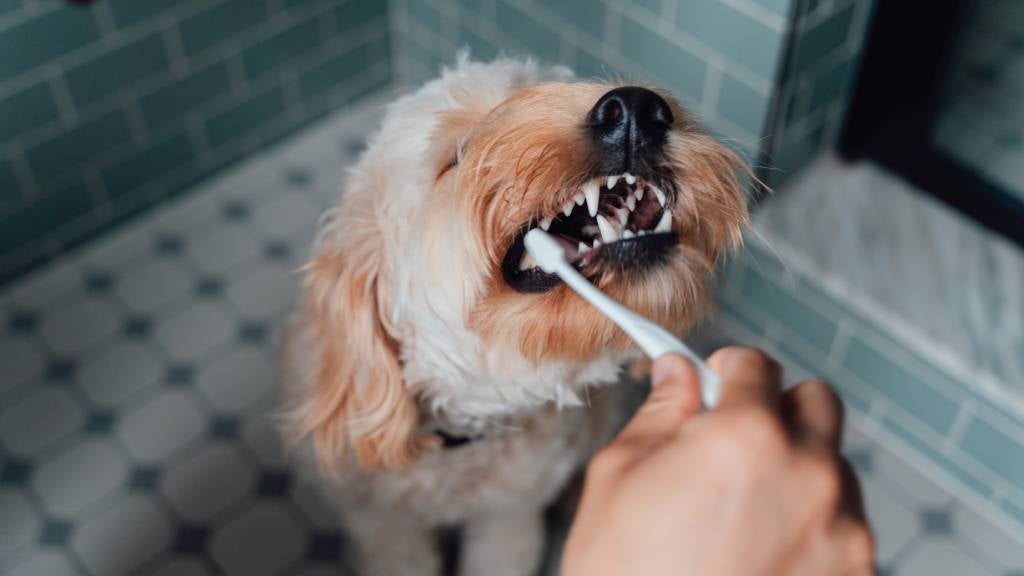Dental hygiene guide for dogs

Dental health isn’t just something we need to be on top of for ourselves – we also need to help our best furry friends look after theirs too.
Dental issues are actually very common in dogs, with as many as 80% of dogs dealing with some form of dental disease by their third year.
The good news is that we can help them reduce dental issues and treat them as soon as they arise. Here’s how to put your pup’s niho (their teeth) first.
Dental treats and food
Many treats and food options offer dental benefits, both through good nutrition and shape and size. But that doesn’t mean it’s a one-size-fits-all approach for your furry friend.
Dr. Helen Beattie (BVSc, Cert Animal Welfare Investigations) agrees - “Many dogs love to chew, and sometimes it can help with oral health, sometimes it’s really bad for it.”
“Dogs that chew and fetch stones don’t do their teeth any favours, while dental specific chews can be a great addition to an oral health programme. Check out the options by talking to your veterinarian for the best options” explains Dr. Beattie.
Crunchy kibble can help to reduce plaque and tartar build up and actively help to clean the tooth’s surface, which can be a big help in improving your dog’s dental health. Opt for treats and food with the Veterinary Oral Health Council seal of approval, which means they have been approved as a product that helps with plaque and tartar.
Be wary of signs of poor dental health
Poor dental health isn’t always easy to notice, especially without specific vet training, but there are signs you can keep in mind.
For example, if your dog starts having bad breath or drooling excessively, it may be worth a call to your vet. Also, if your pup doesn’t have the same appetite as usual, it may be a clinical sign of dental issues, such as pain or irritation in the mouth.
Should you spot anything, make an appointment with your vet as soon as possible to have it checked professionally.
Dental toys
There are numerous toys on the market all designed to help improve your dog’s oral health.
For toys, look for items specifically designed for dental health. These usually come in a variety of textures, and often even involve brushes that will stealthily ‘brush’ your dog’s teeth while they play. It’s not a total replacement for an actual toothbrush, but it can help.
Brushing
Toothbrushes and toothpaste aren’t just for humans!
The best way to reduce dental disease in your dog is to brush their teeth for them. After all, they don’t have opposable thumbs to do it themselves.
Just like in humans, brushing helps prevent build-up of plaque and tartar. You’ll need a special soft brush and paste from your vet or pet shop (do not use human toothpaste, as many contain ingredients that can harm your pet) and a bit of practice, patience and positive reinforcement.
It’s important to create a plan with your vet before undertaking this task at home. “See your vet or behaviourist to get a plan in place for upskilling your dog – they’ll even get a special flavoured, low fluoride pet toothpaste that suits their needs and is safe” says Dr. Beattie.
Regular check-ups
Ultimately, the most important thing is to ensure your dog has regular check-ups with their vet.
As well as checking your dog’s overall health and wellbeing, your vet will inspect their teeth and gums for any signs of discolouration, plaque and tartar, swelling or redness in the gums and other signs of oral disease.
Your vet can provide dental care to your pets, much like a dentist does to you, although for animals that means using an anaesthetic, for safety and so they can do a thorough job. They can offer other advice on looking after your dog’s dental health until the next check-up.
Dogs are our best mates, and that’s why we’ve got to do everything we can to look after their health.
29 Apr 2022